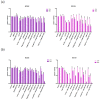Bcl-XL but Not Bcl-2 Is a Potential Target in Medulloblastoma Therapy
- PMID: 35056150
- PMCID: PMC8779796
- DOI: 10.3390/ph15010091
Bcl-XL but Not Bcl-2 Is a Potential Target in Medulloblastoma Therapy
Abstract
Medulloblastoma (MB) is the most common solid tumour in children and, despite current treatment with a rather aggressive combination therapy, accounts for 10% of all deaths associated with paediatric cancer. Breaking the tumour cells' intrinsic resistance to therapy-induced cell death should lead to less aggressive and more effective treatment options. In other tumour entities, this has been achieved by modulating the balance between the various pro- and anti-apoptotic members of the Bcl-2 family with small molecule inhibitors. To evaluate the therapeutic benefits of ABT-199 (Venetoclax), a Bcl-2 inhibitor, and ABT-263 (Navitoclax), a dual Bcl-XL/Bcl-2 inhibitor, increasingly more relevant model systems were investigated. Starting from established MB cell lines, progressing to primary patient-derived material and finally an experimental tumour system imbedded in an organic environment were chosen. Assessment of the metabolic activity (a surrogate readout for population viability), the induction of DNA fragmentation (apoptosis) and changes in cell number (the combined effect of alterations in proliferation and cell death induction) revealed that ABT-263, but not ABT-199, is a promising candidate for combination therapy, synergizing with cell death-inducing stimuli. Interestingly, in the experimental tumour setting, the sensitizing effect of ABT-263 seems to be predominantly mediated via an anti-proliferative and not a pro-apoptotic effect, opening a future line of investigation. Our data show that modulation of specific members of the Bcl-2 family might be a promising therapeutic addition for the treatment of MB.
Keywords: ABT-199 (Venetoclax); ABT-263 (Navitoclax); Bcl-2; Bcl-XL; apoptosis; chemotherapy; medulloblastoma.
Conflict of interest statement
The authors declare no conflict of interest.
Figures










References
-
- Louis D.N., Perry A., Reifenberger G., von Deimling A., Figarella-Branger D., Cavenee W.K., Ohgaki H., Wiestler O.D., Kleihues P., Ellison D.W. The 2016 World Health Organization Classification of Tumors of the Central Nervous System: A summary. Acta Neuropathol. 2016;131:803–820. doi: 10.1007/s00401-016-1545-1. - DOI - PubMed
-
- Ellison D.W., Dalton J., Kocak M., Nicholson S.L., Fraga C., Neale G., Kenney A.M., Brat D.J., Perry A., Yong W.H., et al. Medulloblastoma: Clinicopathological correlates of SHH, WNT, and non-SHH/WNT molecular subgroups. Acta Neuropathol. 2011;121:381–396. doi: 10.1007/s00401-011-0800-8. - DOI - PMC - PubMed
LinkOut - more resources
Full Text Sources
Research Materials
Miscellaneous

